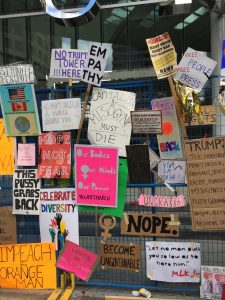Global Feminist Futures
 This photo was taken during the Women’s March, it’s showing the signs left behind on the fence enclosing the Trump Tower in Downtown Vancouver.
This photo was taken during the Women’s March, it’s showing the signs left behind on the fence enclosing the Trump Tower in Downtown Vancouver.
The March which took place after the election of Donald Trump, saw varying levels social justice issues coming to light. The history behind the Women’s March on Washington has to be considered to be able to understand the bigger picture.
The Women’s march acknowledges that the past election failed “Muslims and those of diverse religious faiths, people who identify as LGBTQIA, Native people, Black and Brown people, people with disabilities, survivors of sexual assault”. They speak about how they’re “confronted with the question of how to move forward in the face of national and international concern and fear “. As a result, the Woman’s March encompassed many issues into one, but the question must be asked whether or not grouping these issues together kind of takes some importance away from them.
After the election of Donald Trump many women were angry, sad, even heartbroken by the idea that someone who is full of hatred and and is so narrow-minded now had to speak for millions of Americans. It made me wonder how it was possible to elect someone who hindered the progressive movement. Donald Trump’s proposals that appealed to some American’s nostalgic nationalist ideas, who were anti-globalization, middle class, middle aged, lived in rural areas, and wanted to move against an inclusive and welcoming USA. These hurtful appeals seem to to have little room in a globalizing world, in which becoming secluded and closed off in the global stage is impossible. Countries are so integrated in each others policies that their survival depends on cooperation and understanding.
While addressing the challenges that women will have to face with the election of Donald Trump, it has to be considered how these problems will be worsened for women who aren’t white, it has to be talked about because that’s the only way we can move forward. If we look past their struggles and just incorporate or make mentions of them at protests it’s not enough we must devote significant time and effort to helping each other rather than seeking our own political and social agendas.
Katie MacDonald states in her article that “notions of development which position those in the West as knowers and doers rely on assumptions of superiority, linear progress and Western women’s freedom. (MacDonald, 2016). These ideas are present in which voices are heard. That places many issues together is not enough to demonstrate the issues that women in varying positions have to face.
Rallying together was an effective way to get a universally heard message across, that women across the world are not going to go down without a fight, that Donald Trump’s win is discouraging but for many women the battle is not over. The March was able to bring attention to this issue, but it didn’t show the levels of inequality that affect women. Taking their struggles into consideration is important when considering how feminism is a global issue in which everyone experiences structural injustice differently.